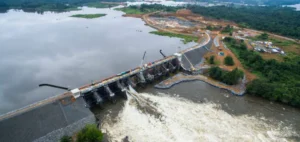Union Minister for Power Shri R.K. Singh and Arunachal Pradesh Chief Minister Shri Pema Khandu have signed a landmark agreement for five 5097 MW hydropower projects. SJVN will carry out these projects to boost energy potential, with an investment of Rs. 50,000 crore.
Historic Agreement signed for 5097 MW Hydroelectric Projects in the State of Arunachal Pradesh
Union Minister for Power Shri R.K. Singh and Arunachal Pradesh Chief Minister Shri Pema Khandu recently concluded a landmark agreement between SJVN and the Arunachal Pradesh government. The agreement covers five hydroelectric projects with a total capacity of 5097 MW in the state. Shri Nand Lal Sharma, CMD of SJVN, and Shri Ankur Garg, Commissioner (Hydropower), Government of Arunachal Pradesh, formally signed the MoU in Itanagar. Several dignitaries, including the Deputy Chief Minister and other senior officials, warmly welcomed the agreement when it was presented.
Hydroelectric projects to boost energy potential
SJVN has been entrusted with the realization of significant hydroelectric projects. The 3097 MW Atalin project, in particular, stands out as the largest project of its kind currently underway in India. These projects were previously in the hands of private developers. The government of Arunachal Pradesh has reallocated them to SJVN, as private developers have failed to complete them. SJVN is committed to completing these projects on schedule.
Major Investments for Energy Expansion
A substantial sum of nearly Rs. 50,000 crore will be invested in the construction of these projects. This will boost the country’s hydroelectric capacity to an estimated 20,652 million units per year. Progress is encouraging, with the Atalin and Atunli projects having already received approval of the CEA’s detailed project report. Other projects currently being prepared by DPR will contribute to continued expansion.
Economic and Socio-Ecological Impact of Projects
A series of positive impacts will be generated when these projects are completed. In addition to increasing energy capacity, projects will include the development of infrastructure such as roads and bridges, as well as the creation of community assets and health services. These projects will also promote women’s empowerment, skills development, education and the creation of multi-dimensional employment opportunities. These advances will benefit local families and contribute to the sustainable development of the state of Arunachal Pradesh.
Progressive Implementation of Hydroelectric Projects
The implementation of hydroelectric projects is progressing with meticulous planning. The pre-feasibility reports for the Emini, Amulin and Mihumdan projects have been drawn up, and preparation of the RPDs is underway. Survey and investigation work will begin shortly. The collaboration between SJVN and the government of Arunachal Pradesh augurs well for the region’s energy and economic future.






















